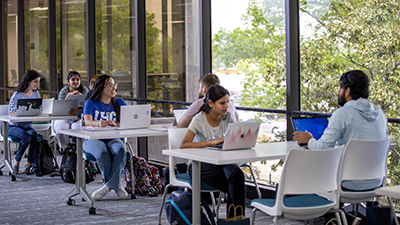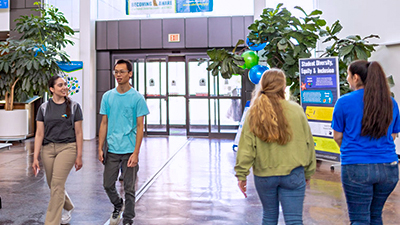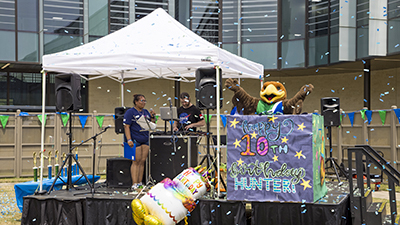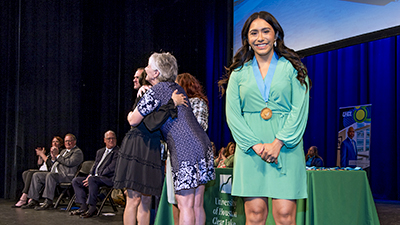Hispanic Heritage Month: UHCL prof discusses bias, police brutality in Latinx community
Recent high-profile incidents have highlighted the impact of police brutality on Black communities in America. These patterns are part of a long history of racist policing and violence in the U.S., says University of Houston-Clear Lake Assistant Professor of Writing and Rhetoric Christina Cedillo.
Her research explores how racial violence affects impressions of citizenship, belonging and self-worth. In studying the history and effects of police brutality among Latinx communities and other racial groups in the U.S., Cedillo calls for unity in opposing anti-Blackness and racism in all its forms.
“History shows that what we now call ‘police brutality’ isn’t just something that happens within the confines of the legal system,” said Cedillo. “Stereotypes and racial anxieties convince white people that they have to take on the role of patrolling ‘other’ people, which is why you see incidents like the one that happened in May involving Amy Cooper, a white woman in Central Park in New York who called the police on an African American man who requested she leash her dog.”
In a now-viral video of the incident, Cooper called police and accused the man of threatening her. “Her assumption was that the police would come and believe her over him,” Cedillo said. “This incident happened the same day as George Floyd’s murder by Minneapolis police. White people are calling the police on people of color for wearing hoodies or for just ‘being.’ We are in the middle of a conversation about police killing people over nothing.”
Many marginalized communities face similar attacks. Cedillo said that her research explores Latinx lynchings that have occurred over centuries. “The brutality itself sends a message to spectators that if you are part of this marginalized group that is being targeted, you could be next,” she said. “We know this from the history of Black lynchings.”
Black and Latinx lynchings are connected, she said, because often, it was local authorities like the Texas Rangers who used lynching to regulate marginalized populations. “One of the things we need to think about regarding police brutality is that it isn’t just the marginalized populations who are getting the message that they aren’t deserving of equal justice; it tells others the same thing,” she said. “Part of police brutality is about how that message circulates in society. These are messages that are not spoken. They’re impressions, and audiences run with them.
“That’s where people say, ‘I’m not racist. I didn’t say that!’ It’s part of the whole structure of what it means to be a citizen—you could be perpetuating racist ideas without realizing it, because people have been taught that racism is only about saying certain bad words. In fact, it’s part of a whole structure,” she said. “There is a lot of meaning conveyed, not in words, but in spaces created.”
“For Latinos, the impression of us being a threat was constructed in the mid-19th century,” she said. “When the U.S. sparked the Mexican-American War and annexed northern Mexico, white settlers wanted to move into those territories, but they were already occupied. They had been living relatively peacefully, but when that territory was ceded to the U.S., people began to debate what to do with the ‘mongrel’ race problem and whether Mexicans should be citizens based on their race.”
Racism, she continued, is created and maintained by certain structures. “Those impressions don’t go away unless they’re discussed straightforwardly. We’re told that if we talk about race, we’re being rude,” she said. “But there were a lot of papers characterizing Mexicans as ‘bandidos’ or gangsters and creating threatening caricatures. It’s been hard to dislodge this image over the last 200 years. The problem with a ‘colorblind’ ideology is that it means we are refusing to see what causes a different experience for someone. We can become more aware of the fact that we live among diverse communities and try to understand people on their terms, not ours.”
Cedillo said it’s also important to discuss these issues with children. “We can talk to kids about issues of inequality, but that is not limited to race,” she said. “It’s about ableism (bias favoring people who are able-bodied) and classism. Black people have been the main target, but Latinos are a ‘wedge’ group. We aren’t always the primary targets, but there’s still a lot of violence toward us. What we need to remember is, Black parents have no choice about educating their children about these issues.
“And so, if we can overturn a racist system and resolve problems of anti-Blackness, we deal with many of ours as well. Interrupting the process is crucial. Excluding others is learned, so it can be unlearned.”
This is the third in a series of features spotlighting Hispanic Heritage Month at UHCL. Embark on a month-long journey through Hispanic culture by participating in events planned university-wide.







